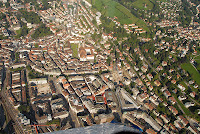The Swiss city of St Gallen is linked with high quality embroideries used by leading fashion designers around the world. It is also a beautiful town with a long history and a picturesque historic city center. At its very center stands the magnificent monastery dedicated to St Gall with its baroque cathedral and UNESCO World Heritage library.
The monastery of St Gall was founded in 719 and was dedicated to the Irish hermit St Gall who had lived and died somewhere nearby. The monastery's founder St Othmar was made an abbot by the king of the Francs. The pope decreed that the monks could choose their abbot themselves without recourse to or approval from Rome and gave him the rank of a bishop. The monastery existed until 1805 when all monasteries in Switzerland were secularized. Today, the Bishop of St Gallen is still chosen by the local governing Church body. The result of the vote is then mailed to Rome for confirmation but not approval.
From its earliest days, the monastery had two schools attached, one for future monks and one for the sons of local nobility and rich merchants. On his visit, Pope Gregory IV (died 844) was so impressed by schools and pupils that he decreed a special holiday to be held for children. This day is still an official holiday in the city commemorated with a great procession in which only children are allowed to take part. Town and monastery were burnt down by the Magyars in 926 and again due to an accident in 937.
In 947, the abbot was ennobled to the rank of a prince by the emperor of the Holy Roman Empire. His power in the city was absolute, but it waned over the centuries as the inhabitants of the city acquired, earned, usurped, or bought more freedom and rights. When the abbey lost its hold over the county of Appenzell and its tax income, the prince-abbot called on the loyal subjects in town and countryside to help him regain sovereignty. Appenzell had joined the Swiss Confederation in 1411 and could expect armies to its aid from the other member states. The citizens considered their options, paid the Holy Roman Emperor to declare them a free imperial city, and joined the Swiss Confederation in turn.
The city later joined the Protestant Church; this made cathedral and monastery a Catholic island in its midst. After the defeat of Napoleon, St Gallen regained its freedom as a republic but was then swallowed up in the new Swiss state of 1848. At that point, it lost any political influence. It remains an important Catholic center, though, especially as the Holy See has no influence over the choice of its bishops. St Gall is today the seat of the Swiss High Court for Administrative Law.
St Gallen became a center for linen production in the 17th century. St Gallen became at that point a byword for the highest quality linen that could be bought anywhere in the world. When demand for linen sank, St Gallen was already established as a center for artful embroidery; it's an industry that endured to today. To commemorate the success of St Gallen's embroidery industry, Swiss Post issued the first embroidered stamp in the world. Its face value was five Swiss Francs (£2.50; US$ 3.50) and covered the charge for registered mail. It’s one of the few modern postage stamps having gained in value by at least a factor 100 over its face value.
The language spoken in town is Alemannic. The rest of Switzerland makes fun of the local dialect because it has lost vowel sounds as in bow or how and replaced it by an o as in stork. This language shift makes the use of certain words quite confusing for other Alemannic speakers. Besides various saints and Protestant reformer Vadian, the most well known inhabitant was King Gustav IV Adolf of Sweden who spent his exile years to his death in 1837 in the city.
Besides cathedral, monastery, and cloister, a visit to the monastery library is a must. The library owns over 600 books written and illustrated before the year 900. The city houses an excellent museum for embroidery showing how well known pictures were adapted for embroidery purposes. The town is also known as the city of bay windows. I was told there were 111 bay windows of historical significance that can all be seen during a walk of less than an hour.









No comments:
Post a Comment